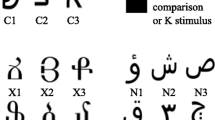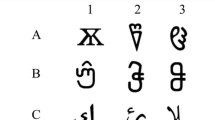Abstract
The present study was conducted to show how responding in accord with equivalence relations changes as a function of position of familiar stimuli, pictures, and with the use of nonsense syllables in an MTO-training structure. Fifty college students were tested for responding in accord with equivalence in an AB, CB, DB, and EB training structure. The results showed that familiar stimuli presented as A-stimuli gave the highest yields (10 of 10 participants), whereas introducing the pictures at the end of the training (as E-stimuli) gave lower yields (5 of 10), and using nonsense syllables gave even lower yields (4 of 10). In addition, when all stimuli were Greek/Arabic letters only, 3 of 10 participants responded in accord with equivalence. When familiar stimuli were A-stimuli, but with a requirement of using keys on the keyboard, only 4 of 10 subjects responded in accord with equivalence. Furthermore, there was a high correlation between responding in accord with equivalence and reports of class consistent naming. Reaction time data also showed a typical pattern, in which there was an increase from training to test and a decrease during testing.
Similar content being viewed by others
References
ANNETT, J. M., & LESLIE, J. C. (1995). Stimulus classes involving olfactory stimuli. The Psychological Record, 45, 439–450.
ARNTZEN, E., & HOLTH, P. (1997). Probability of stimulus equivalence as a function of training design. The Psychological Record, 47, 309–320.
ARNTZEN, E., & HOLTH, P. (2000a). Differential equivalence test outcomes as a function of training structure and class number. The Psychological Record, 50, 603–628.
ARNTZEN, E., & HOLTH, P. (2000b). Probability of stimulus equivalence as a function of class size vs. number of classes. The Psychological Record, 50, 79–104.
BARNES-HOLMES, D., HAYES, S. C., & ROCHE, B. (2001). The (not so) strange death of stimulus equivalence. European Journal of Behavior Analysis, 2, 35–41.
BELANICH, J., & FIELDS, L. (1999). Tactual equivalence class formation and tactual-to-visual cross-modal transfer. The Psychological Record, 49, 75–91.
BENTALL, R. P., JONES, R. M., & DICKINS, D. W. (1999). Errors and response latencies as a function of nodal distance in 5-member equivalence classes. The Psychological Record, 49, 93–115.
CATANIA, A. C. (1980). Autoclitic processes and the structure of behavior. Behaviorism, 8, 175–186.
CATANIA, A. C. (1986). On the difference between verbal and nonverbal behavior. The Analysis of Verbal Behavior, 4, 2–9.
CULLINAN, V. A., BARNES-HOLMES, D., & SMEETS, P. M. (2000). A precursor to the relational evaluation procedure: Analyzing stimulus equivalence II. The Psychological Record, 50, 467–492.
DE ROSE, J. C. (1996). Controlling factors in conditional discriminations and tests of equivalence. In T. R. Zentall & P. M. Smeets (Eds.), Stimulus class formation in humans and animals (pp. 253–277). Amsterdam: Elsevier.
DEVANY, J. M., HAYES, S. C., & NELSON, R. O. (1986). Equivalence class formation in language-able and language-disabled children. Journal of the Experimental Analysis of Behavior, 46, 243–257.
DUGDALE, N., & LOWE, C. F. (2000). Testing for symmetry in the conditional discriminations of language-trained chimpanzees. Journal of the Experimental Analysis of Behavior, 73, 5–22.
EIKESETH, S., & SMITH, T. (1992). The development of functional and equivalence classes in high-functioning autistic children: The role of naming. Journal of the Experimental Analysis of Behavior, 58, 123–133.
FIELDS, L., VARELAS, A., REEVE, K. F., BELANICH, J., WADHWA, P., DEROSSE, P., & ROSEN, D. (2000). Effects of prior conditional discrimination training, symmetry, transitivity, and equivalence testing on the emergence of new equivalence classes. The Psychological Record, 50, 443–466.
FIELDS, L., & VERHAVE, T. (1987). The structure of equivalence classes. Journal of the Experimental Analysis of Behavior, 48, 317–332.
FIELDS, L., VERHAVE, T., & FATH, S. (1984). Stimulus equivalence and transitive associations: A methodological analysis. Journal of the Experimental Analysis of Behavior, 42, 143–157.
GREEN, G., & SAUNDERS, R. R. (1998). Stimulus equivalence. In K. A. Lattal & M. Perone (Eds.), Handbook of research methods in human operant behavior (pp. 229–262). New York: Plenum Press.
HAYES, L. J., TILLEY, K. L., & HAYES, S. C. (1988). Extending equivalence and membership to gustatory stimuli. The Psychological Record, 38, 473–482.
HAYES, S. C. (1989). Nonhumans have not yet shown stimulus equivalence. Journal of the Experimental Analysis of Behavior, 51, 385–392.
HOLTH, P., & ARNTZEN, E. (1998). Stimulus familiarity and the delayed emergence of stimulus equivalence or consistent nonequivalence. The Psychological Record, 48, 81–110.
HOLTH, P., & ARNTZEN, E. (2000). Reaction times and the emergence of class consistent responding: A case for precurrent responding? The Psychological Record, 50, 305–338.
HORNE, P. J., & LOWE, C. F. (1996). On the origins of naming and other symbolic behavior. Joumal of the Experimental Analysis of Behavior, 65, 181–241.
IMAM, A. A. (2001). Speed contingencies, number of stimulus presentations, and the nodality effect in equivalence formation. Joumal of the Experimental Analysis of Behavior, 76, 265–288.
LANE, S. D., & CRITCHFIELD, T. S. (1996). Verbal self-reports of emergent relations in a stimulus equivalence procedure. Joumal of the Experimental Analysis of Behavior, 65, 355–374.
LANE, S. D., & CRITCHFIELD, T. S. (1998). Classifications of vowels and consonants by individuals with moderate and mental retardation: Development of arbitrary relations via matching-to-sample training with compound stimuli. Joumal of Applied Behavior Analysis, 31, 21–41.
LAZAR, R., DAVIS-LANG, D., & SANCHEZ, L. (1984). The formation of visual stimulus equivalence in children. Journal of the Experimental Analysis of Behavior, 41, 251–266.
LIPKINS, R., HAYES, S. C., & HAYES, L. J. (1993). Longitudinal study of the development of derived relations in an infant. Journal of Experimental Child Psychology, 56, 201–239.
LOWE, C. F., HORNE, P. J., HARRIS, F. D. A., & RANDLE, V. R. L. (2002). Naming and categorization in young children: vocal tact training. Journal of the Experimental Analysis of Behavior, 78, 527–549.
MANDELL, C., & SHEEN, V. (1994). Equivalence class formation as a function of the pronounceability of the sample stimulus. Behavioural Processes, 32, 29–46.
MCINTIRE, K. D., CLEARY, J., & THOMPSON, T. (1987). Conditional relations by monkeys: Reflexivity, symmetry, and transitivity. Journal of the Experimental Analysis of Behavior, 47, 279–285.
MCINTIRE, K. D., CLEARY, J., & THOMPSON, T. (1989). Reply to Saunders and to Hayes. Journal of the Experimental Analysis of Behavior, 51, 393–396.
O’LEARY, C. A., & BUSH, K. M. (1996). Stimulus equivalence in the tactile modality. The Psychological Record, 46, 509–517.
PEAR, J. J. (2001). The science of learning. Philadelphia, PA: Psychology Press.
PILGRIM, C., CHAMBERS, L., & GALIZIO, M. (1995). Reversal of baseline relations and stimulus equivalence: II. Children. Journal of the Experimental Analysis of Behavior, 63, 225–238.
RANDELL, T., & REMINGTON, B. (1999). Equivalence relations between visual stimuli: The functional role of naming. Journal of the Experimental Analysis of Behavior, 71, 395–415.
ROCHE, B., BARNES-HOLMES, D., SMEETS, P. M., BARNES-HOLMES, Y., & MCGEADY, S. (2000). Contextual control over derived transformation of discriminative and sexual arousal functions. The Psychological Record, 50, 267–291.
SAUNDERS, K. J. (1989). Naming in conditional discrimination and stimulus equivalence. Journal of the Experimental Analysis of Behavior, 51, 379–384.
SAUNDERS, K. J., & SPRADLIN, J. E. (1993). Conditional discrimination in mentally retarded subjects: Programming acquisition and learning set. Journal of the Experimental Analysis of Behavior, 60, 571–585.
SAUNDERS, R. R., SAUNDERS, K. J., KIRKBY, K. C., & SPRADLIN, J. E. (1988). The merger and development of equivalence classes by unreinforced conditional selection of comparison stimuli. Journal of the Experimental Analysis of Behavior, 50, 145–162.
SIDMAN, M. (1992). Equivalence relations: Some basic considerations. In S. C. Hayes & L. J. Hayes (Eds.), Understanding verbal relations (pp. 15–27). Reno, NV: Context Press.
SIDMAN, M. (1994). Equivalence relations and behavior: A research story. Boston: Authors Cooperative.
SIDMAN, M. (2000). Equivalence relations and the reinforcement contingency. Journal of the Experimental Analysis of Behavior, 74, 127–146.
SIDMAN, M., CRESSON, O., & WILLSON-MORRIS, M. (1974). Acquisition of matching to sample via mediated transfer. Journal of the Experimental Analysis of Behavior, 22, 261–273.
SIDMAN, M., KIRK, B., & WILLSON-MORRIS, M. (1985). Six members stimulus classes generated by conditional-discrimination procedures. Journal of the Experimental Analysis of Behavior, 43, 21–42.
SIDMAN, M., & TAILBY, W. (1982). Conditional discrimination vs. matching to sample: An expansion of the testing paradigm. Journal of the Experimental Analysis of Behavior, 37, 5–22.
SIDMAN, M., WILLSON-MORRIS, M., & KIRK, B. (1986). Matching-to-sample procedures and the development of equivalence relations: The role of naming. Analysis and Intervention in Developmental Disabilities, 6, 1–29.
SKINNER, B. F. (1968). The technology of teaching. New York: Prentice-Hall, Inc.
SPENCER, T. J., & CHASE, P. N. (1996). Speed analysis of stimulus equivalence. Journal of the Experimental Analysis of Behavior, 65, 643–659.
STROMER, R., & MACKAY, H. A. (1996). Naming and the formation of stimulus classes. In T. R. Zentall & P. M. Smeets (Eds.), Stimulus class formation in humans and animals (pp. 221–252). Amsterdam: Elsevier.
TONNEAU, F. (2001). Equivalence relations: A critical analysis. European Journal of Behavior Analysis, 2, 1–33.
WULFERT, E., DOUGHER, M. J., & GREENWAY, D. E. (1991). Protocol analysis of the correspondence of verbal behavior and equivalence class formation. Journal of the Experimental Analysis of Behavior, 56, 489–504.
Author information
Authors and Affiliations
Corresponding author
Additional information
Some results were presented in a paper at the ABA convention in Washington DC, May 2000. Thanks to Per Holth and Lanny Fields for comments on parts of an earlier draft and two anonymous reviewers for comments and suggestions during the reviewing process. I also thank Dag Erik Eilertsen for statistical assistance.
Rights and permissions
About this article
Cite this article
Arntzen, E. Probability of Equivalence Formation: Familiar Stimuli and Training Sequence. Psychol Rec 54, 275–291 (2004). https://doi.org/10.1007/BF03395474
Published:
Issue Date:
DOI: https://doi.org/10.1007/BF03395474




